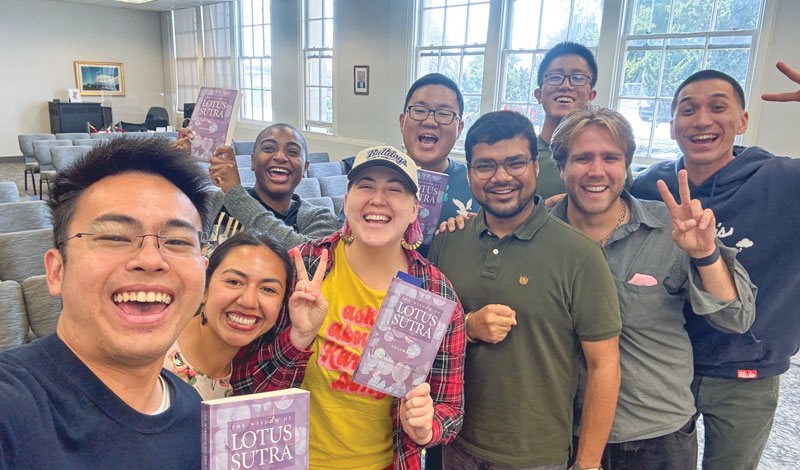Ikeda Wisdom Academy members:
• are group through national youth leaders and all student division members.
• should have their own copy of The Wisdom of the Lotus Sutra, vol. 4.
• are encouraged to read the assigned material before each meeting.
November Syllabus:
The Wisdom of the Lotus Sutra, vol. 4, pp. 227–47
Part Three: “The Life Span of the Thus Come One” Chapter: The Eternity of Life
9: “Testimony to the Eternity of Life”
Supplementary Material:
• The Lotus Sutra and Its Opening and Closing Sutras, p. 267
• “The Importance of the Moment of Death,” The Writings of Nichiren Daishonin, vol. 2, pp. 759–61
• “The Unanimous Declaration by the Buddhas of the Three Existences,” WND-2, 843
Chapter Overview
Overcoming the ‘Suffering of Death’
For the next three months, we will focus on the Buddhist view of life and death. This month, we begin with chapter 9 of The Wisdom of the Lotus Sutra, vol. 4, examining perspectives on the afterlife, near-death experiences and Nichiren Buddhism’s view. Ikeda Sensei points to this key passage from Nichiren Daishonin’s writings:
Looking back, I have been studying the Buddha’s teachings since I was a boy. And I found myself thinking, “The life of a human being is fleeting. The exhaled breath never waits for the inhaled one. Even dew before the wind is hardly a sufficient metaphor. It is the way of the world that whether one is wise or foolish, old or young, one never knows what will happen to one from one moment to the next. Therefore I should first of all learn about death, and then about other things. (“The Importance of the Moment of Death,” The Writings of Nichiren Daishonin, vol. 2, p. 759)
In terms of first understanding death, there are various views on what happens after we die. Some see life ending completely after death, while others believe in an unchanging “soul” that separates from one’s body at death and continues forever.
Many near-death testimonials from various cultures and religions share similarities that point to the possibility of a continued existence after death. But no conclusion can be proven, given that none of us can really know until we cross that threshold.
Ikeda Sensei cites Blaise Pascal’s “wagering theory”: Gambling on the chance that there is life after death and helping others and making good causes leaves nothing to lose. While gambling on the belief that there is no life after death and living recklessly could bring regret if in fact there is an afterlife.
Our view of death determines our attitudes toward this present life as well as the people around us. Sensei says:
There may be some who live out their lives convinced that death is the absolute end of their existence. But what kind of comfort could such a person give to a close relative or family member who is suffering in the face of imminent death? Would such a conviction and view of life and death ultimately provide any hope?
The Buddhist perspective of life as existing eternally over the three existences of past, present and future not only brings hope to oneself, it can also encourage and give strength and hope to others. (The Wisdom of the Lotus Sutra, vol. 4, pp. 242–43)
Nichiren Buddhism views life as merging back into the universe at death, then reemerging once again in birth in an unending cycle of birth and death. This perspective can offer comfort in the face of death and a way to create the most value in this lifetime and beyond.
—Prepared by the SGI-USA Study Department
Ikeda Sensei’s Guidance
Understanding Death Sheds Light on How to Live Right Now
Ikeda Sensei: Nichiren Daishonin says, “Only in the Life Span chapter of the essential teaching is to be found the vital doctrine needed to free one from the sufferings of birth and death” (“On the Receiving of the Three Great Secret Laws,” The Writings of Nichiren Daishonin, vol. 2, p. 985).
How we perceive the meaning of death and the meaning of life hinges completely on whether we are able to establish a correct view of life and death. Goethe says, “Those who have no hope of another life are already dead in this one.”[1]
We study Buddhism to live vibrantly and with eternal hope. Will death, which inevitably comes to each of us, be a time of dignity and honor? Or will we end in pitiful demise? This is completely reliant on how we live our lives right now, today. In that sense, the moment of death truly exists in the present. (WLS-4, 246)
Digging Deep
November Study Guide
Please use these questions to guide your study of The Wisdom of the Lotus Sutra, vol. 4, pp. 227–47.
1) On the subject of death, Nichiren Daishonin states: “The life of a human being is fleeting … Therefore I should first of all learn about death, and then about other things” (“The Importance of the Moment of Death,” WND-2, 759). How does Ikeda Sensei describe the instant before we die? (WLS-4, 233)
2) In describing the relationship between memory and the brain, British biologist Rupert Sheldrake uses the analogy of televised images and sounds, and the television receiver. While the TV receives and displays images, it doesn’t mean that the images exist inside the TV. What does Sensei say this analogy suggests about the mind and brain? (WLS-4, 244–45)
Looking Forward: December Syllabus
The Wisdom of the Lotus Sutra, vol. 4, pp. 249–75
Part Three: “The Life Span of the Thus Come One”: The Eternity of Life
10: “The Meaning of Eternal Life”
From the November Living Buddhism
References
- J. P. Eckermann, Conversations with Goethe, trans. Gisela C. O’Brien (New York: Frederick Ungar Publishing Co., 1964), p. 33. ↩︎
You are reading {{ meterCount }} of {{ meterMax }} free premium articles

